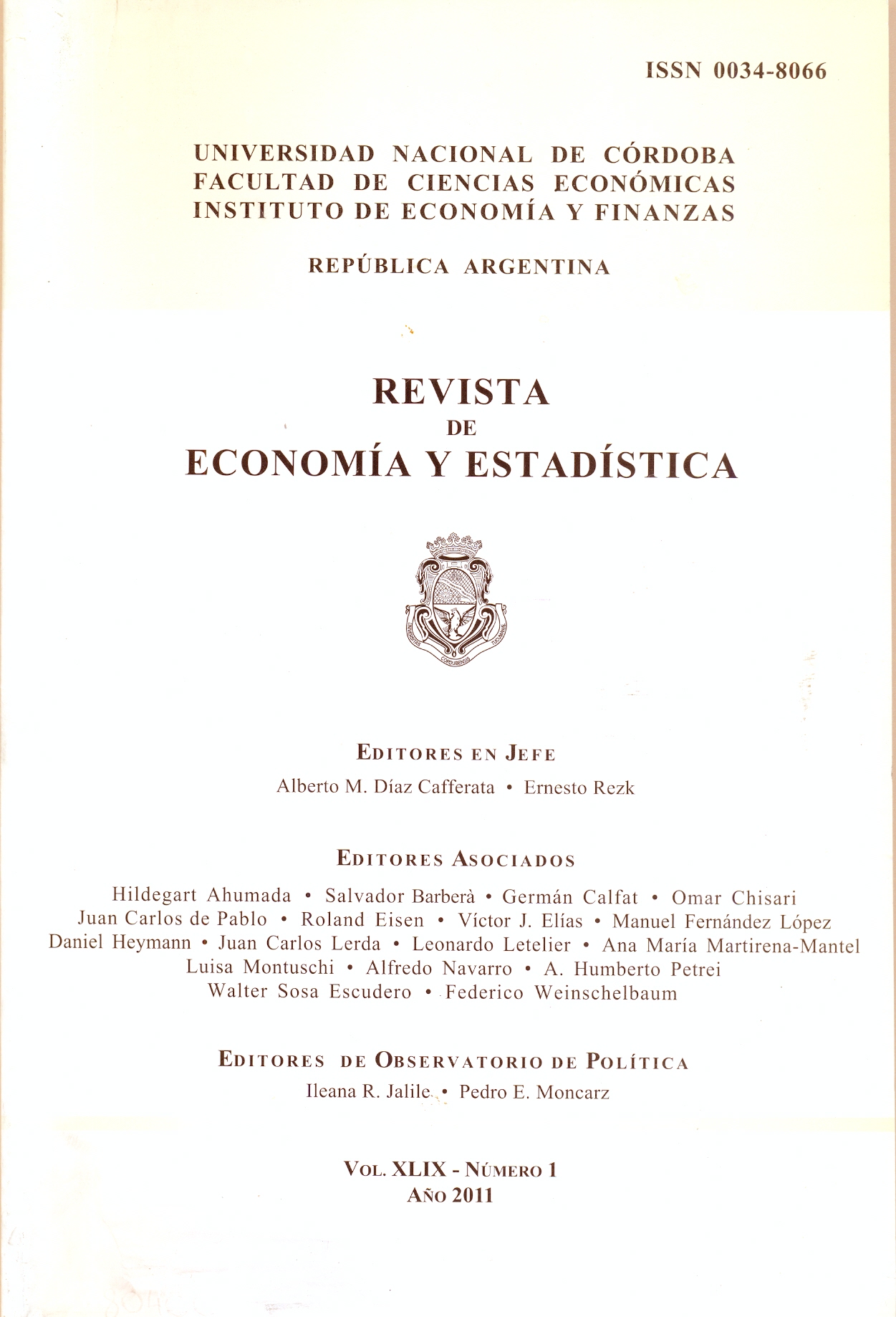The Relationship between Interregional Trade and Transport Connectivity in Spain. A spatial dependency analysis
DOI:
https://doi.org/10.55444/2451.7321.2011.v49.n1.6507Keywords:
inter-regional trade, transport connectivity, spatial dependence, Spanish regionsAbstract
This article analyzes the influence of transport connectivity on trade flows between regions from the perspective of spatial dependence. To do this, we consider two neighborhood criteria in a spatially autoregressive gravity model. The first geographic criteria is first-contiguity , and secondly we incorporate transport connectivity. The results show the importance of logistics platforms to meet the demand for transport infrastructure in the Spanish regions. Since it is not common to have disaggregated database on trade flows within a country, or regional indicators of the degree of development of logistics, this also justifies the need for progress in the achievement of such information for other regions and countries.
Downloads
References
Anselin, L. (1988). Spatial econometrics: methods and models (Vol. 4). Kluwer Academic Pub.
Anselin, L. (1998). “Lagrange Multiplier Tests for Spatial Dependence and Spatial Heterogeneity.” Geographical Analysis 20:1–17.
Anselin, L. y Bera, A. K. (1996). "Spatial Dependence in Linear Regression Models with an Introduction to Spatial Econometrics", Research Paper 9617, Regional Research Institute, West Virginia University, Morgantown, WV.
Anderson, J. E. (1979). “A Theoretical Foundation for the Gravity Equation” American Economic Review, Vol. 69 (1), 106-116.
Banco Mundial (2011). Logistics Performance Index (http://data.worldbank.org/indicator). The World Bank Group.
Bergstrand, J. H. (1985). “The gravity equation in international trade: Some microeconomic foundations and empirical evidence”, The Review of Economics and Statistics 67(3), 474-481.
Bergstrand, J. H. (1989). “The generalized gravity equation, monopolistic competition, and the factorproportions theory in international trade”, The Review of Economics and Statistics 71(1), 143-153.
Behrens, K., Ertur, C., y Koch, W. (2009): ‘Dual’gravity: Using spatial econometrics to control for multilateral resistance. Université d'Orléans, mimeo.
Bolduc, D., Dagenais, M. G., y Gaudry, M. J. (1989). “Spatially autocorrelated errors in origin-destination models: A new specification applied to aggregate mode choice”. Transportation Research Part B: Methodological 23(5), 361–372.
Clark, X., D. Dollar, y A. Micco (2004). “Port efficiency, maritime transport costs, and bilateral trade”. Journal of Development Economics 75(2), 417–450.
Cliff, A. y Ord, J. (1981). Spatial Processes. Models and Applications. Pion, London.
Cliff A D y Ord, J K (1972). "Testing for spatial autocorrelation among regression residuals." Geographical Analysis 4, 267-284.
Cliff, A. D. y Ord, J. K. (1973): Spatial Autocorrelation. Pion, London
Cohen, J. P. (2010). “The broader effects of transportation infrastructure: Spatial econometrics and productivity approaches”. Transportation Research Part E: Logistics and Transportation Review 46 (3), 317–326.
Deardorff, A. V. (1995). “Determinants of bilateral trade: Does gravity work in a Neo-classical word?” NBER Working Paper 5377.
Geary, R. (1954). "The contiguity ratio and statistical mapping", The Incorporated Statistician 5, 115-145.
Kelejian H.H. y Prucha I.R. (1999). "A Generalized Moments Estimator for the Autoregressive Parameter in a Spatial Model", International Economic Review 40, 509-533.
LeSage J.P. y Pace R.K. (2004). Introduction to Spatial and Spatiotemporal in Spatial and Spatiotemporal Econometrics. Vol. 18. Oxford: Elsevier Ltd.
LeSage J.P. y Pace R.K. (2008). "Spatial econometric modeling of origin-destination flows." Journal of Regional Science 5, 941-967.
LeSage, J. P. y Llano, C. (2006). “A Spatial Interaction Model With Spatially Structured Origin and Destination Effects”, SSRN: http://ssrn.com/abstract=924603
LeSage, J. P., y Polasek W. (2008). "Incorporating transportation network structure in spatial econometric models of commodity flows." Spatial Economic Analysis 3 (2), 225-245.
LeSage. J. P. (1997). "Regression analysis of spatial data" Regional analysis and Policy 27 (2), 83-94.
Limao, N. y Venables, A.J. (2001). “Infrastructure, Geographical Disadvantage and Transport Costs.” World Bank Economic Review 15, 451-479.
Linnemann, H. (1966). An Econometric Study of International Trade Flows. Amsterdam: North-Holland Publishing Company.
Llano C., Esteban, A., Pérez, J. y Pulido, A. (2010). “Opening the Interregional Trade Black Box: The Cintereg Database for the Spanish Economy (1995-2005)”. International Regional Science Review 33(3), 302-337.
Márquez-Ramos, L., Martínez-Zarzoso, I., Pérez-García, E. y Wilmsmeier, G. (2011). “Special Issue on Latin-American Research” Maritime Networks, Services Structure and Maritime Trade. Networks and Spatial Economics 11, 555-76.
Martínez-Zarzoso, I., García-Menéndez, L. y Suárez-Burguet, C. (2003). “Impact of Transport Costs on International Trade: The Case of Spanish Ceramic Exports”. Maritime Economics and Logistics 5(2), 179-198.
Micco, A. y Serebrisky, T. (2004). “Infrastructure, competition regimes, and air transport costs: Crosscountry evidence.” Policy Research Working Paper Series 3355, The World Bank.
Moran, P. (1948). “The interpretation of statistical maps", Journal of the Royal Statistical Society, 59, pp. 185-193.
Moreno, R. y E. Vayá (2000). Técnicas econométricas para el tratamiento de datos espaciales: La Econometría Espacial, Edicions Universitat de Barcelona, n. 44.
Pace R.K. y Barry R. (1997). "Sparse Spatial autoregressions", Statistics and Probability Letters 33 (3), 291-297.
Paelinck J. H. P. y Klaassen L. H. (1979). Spatial Econometrics. England: Saxon House.
Porojan, A. (2001). Trade flows and spatial effects: the gravity model revisited. Open Economies Review 12(3), 265-280.
Sanchez, R.J., J. Hoffmann, A. Micco, G.V. Pizzolitto, M. Sgut y Wilmsmeier, G. (2003). “Port Efficiency and International Trade: Port Efficiency as a Determinant of Maritime Transport Costs”. Maritime Economics & Logistics, 5, 199–218.
Solakivi, T., L. Ojala , J. Töyli, H. Hälinen, H. Lorentz, K. Rantasila y T. Naula (2009). Finland State of Logistics 2009. Report for the Finish Ministry of Transport and Communications 21/2009, Helsinki.
Suárez-Burguet (dir) (2010): Definición de una red española de plataformas logísticas (RELOG). Informe técnico, mimeo, Ministerio de Fomento, Madrid.
Tinbergen, J. (1962). Shaping the World Economy. New York: Twentieth Century Fund.
Vázquez García, J. A., Lomba Monjardín, R. (2000). “La industria asturiana, un sector en transformación.” Economía Industrial 335-336, pp. 111-122.
Wilson, J. S., C. L. Mann, y T. Otsuki (2004). “Assessing the Potential Benefit of Trade Facilitation: A Global Perspective”. Working Paper 3224, Banco Mundial.
Downloads
Published
How to Cite
Issue
Section
License
Copyright (c) 2011 Luisa Alamá-Sabater, Laura Márquez-Ramos, Celestino Suárez-Burguet

This work is licensed under a Creative Commons Attribution-NonCommercial-NoDerivatives 4.0 International License.
Authors who have publications with this journal agree to the following terms:
Authors retain their copyright and grant the journal the right of first publication of their work, which is simultaneously subject to the Creative Commons Attribution-NonCommercial-NoDerivatives 4.0 International License that allows third parties to share the work provided that its author and first publication in this journal are indicated.
Authors may adopt other non-exclusive licensing arrangements for distribution of the published version of the work (e.g. depositing it in an institutional telematic archive or publishing it in a monographic volume) as long as the initial publication in this journal is indicated.
Authors are allowed and encouraged to disseminate their work via the Internet (e.g. in institutional telematic archives or on their website) before and during the submission process, which can lead to interesting exchanges and increase citations of the published work. (See The Open Access Effect)









